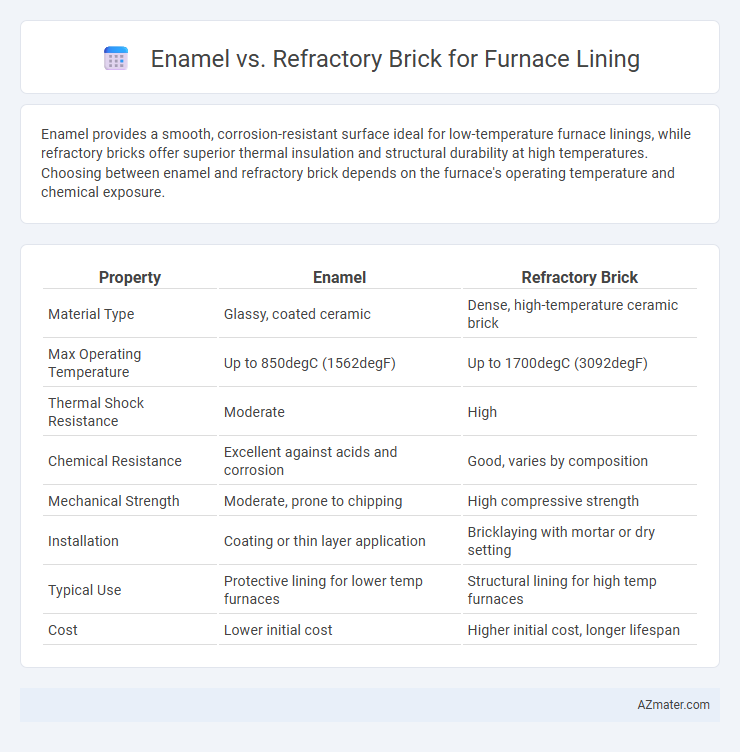Enamel provides a smooth, corrosion-resistant surface ideal for low-temperature furnace linings, while refractory bricks offer superior thermal insulation and structural durability at high temperatures. Choosing between enamel and refractory brick depends on the furnace's operating temperature and chemical exposure.
Table of Comparison
| Property | Enamel | Refractory Brick |
|---|---|---|
| Material Type | Glassy, coated ceramic | Dense, high-temperature ceramic brick |
| Max Operating Temperature | Up to 850degC (1562degF) | Up to 1700degC (3092degF) |
| Thermal Shock Resistance | Moderate | High |
| Chemical Resistance | Excellent against acids and corrosion | Good, varies by composition |
| Mechanical Strength | Moderate, prone to chipping | High compressive strength |
| Installation | Coating or thin layer application | Bricklaying with mortar or dry setting |
| Typical Use | Protective lining for lower temp furnaces | Structural lining for high temp furnaces |
| Cost | Lower initial cost | Higher initial cost, longer lifespan |
Introduction to Furnace Lining Materials
Furnace lining materials play a crucial role in ensuring thermal efficiency and durability under extreme temperatures. Enamel linings offer a smooth, corrosion-resistant surface ideal for chemical resistance but may lack the high-temperature stability found in refractory bricks. Refractory bricks withstand intense heat and mechanical wear, making them a preferred choice for high-temperature furnace environments requiring robust thermal insulation.
What is Enamel Brick?
Enamel brick is a type of refractory brick coated with a smooth, glassy enamel layer designed to enhance durability and corrosion resistance in high-temperature furnace linings. This ceramic coating provides excellent resistance to chemical attack and thermal shock, making enamel bricks ideal for environments exposed to aggressive slags and molten materials. Their unique surface properties help maintain structural integrity and reduce maintenance costs compared to standard refractory bricks.
What is Refractory Brick?
Refractory brick is a high-temperature-resistant material specifically designed for furnace linings, capable of withstanding extreme heat without melting or degrading. Composed primarily of alumina, silica, and other heat-resistant minerals, refractory bricks provide excellent thermal insulation and structural integrity in industrial furnaces. Their durability and resistance to thermal shock make them essential for maintaining efficient and safe furnace operation compared to enamel coatings, which are less heat-resistant and prone to damage under intense thermal conditions.
Thermal Resistance: Enamel vs Refractory Brick
Enamel coatings offer moderate thermal resistance, typically effective up to temperatures around 800degC (1472degF), making them suitable for applications with lower heat exposure. Refractory bricks, composed of high-grade alumina or silica, provide superior thermal resistance, withstanding temperatures exceeding 1600degC (2912degF) while maintaining structural integrity. The choice between enamel and refractory brick for furnace lining depends on the operating temperature requirements and the need for durability under intense thermal stress.
Chemical Durability and Corrosion Resistance
Refractory bricks exhibit superior chemical durability and corrosion resistance compared to enamel coatings due to their composition of alumina, silica, and other oxides designed to withstand high-temperature chemical attacks. Enamel linings, while providing a smooth and non-porous surface resistant to certain acids and alkalis, generally lack the long-term stability and resistance to molten slags or alkali vapor corrosion seen in refractory bricks. The dense microstructure and thermal stability of refractory bricks make them ideal for furnace linings exposed to aggressive chemical environments and cyclic thermal stresses.
Mechanical Strength and Structural Stability
Refractory bricks exhibit superior mechanical strength and structural stability compared to enamel coatings, making them ideal for furnace linings that endure high thermal and mechanical stresses. Their dense composition resists cracking and deformation under extreme temperatures, ensuring long-term durability and reliable support for furnace operations. Enamel coatings, while resistant to corrosion and chemical attack, lack the robust mechanical integrity required for structural furnace lining applications.
Installation and Maintenance Considerations
Enamel furnace linings require precise installation techniques, including careful surface preparation and controlled curing temperatures to ensure durability and optimal thermal resistance, while refractory bricks demand skilled masonry work to achieve proper jointing and alignment crucial for thermal insulation. Maintenance of enamel linings involves periodic inspections for chips or cracks that could expose the base material to corrosion, necessitating prompt repairs to maintain integrity, whereas refractory brick linings require regular monitoring for spalling or thermal degradation and occasional replacement of damaged bricks to prevent heat loss and structural failure. Both materials demand adherence to manufacturer guidelines and environmental controls during installation and maintenance to maximize furnace performance and lifespan.
Cost Comparison and Economic Viability
Enamel linings generally offer lower upfront costs compared to refractory bricks, making them an attractive option for furnaces requiring moderate thermal resistance and durability. Refractory bricks, while more expensive initially, provide superior longevity and thermal insulation, resulting in lower maintenance and replacement expenses over time. An economic viability analysis often favors refractory bricks in high-temperature applications due to their extended service life and reduced operational downtime.
Applications Best Suited for Each Material
Enamel furnace linings excel in applications requiring high chemical resistance and smooth surfaces, such as in glass melting furnaces and chemical processing equipment. Refractory bricks are best suited for high-temperature industrial furnaces, including steelmaking, cement kilns, and petrochemical reactors, due to their superior thermal shock resistance and mechanical strength. Choosing between enamel and refractory brick depends on operational temperature, chemical exposure, and mechanical wear conditions in furnace environments.
Conclusion: Choosing the Optimal Furnace Lining
Enamel and refractory bricks each offer distinct advantages for furnace lining, with enamel providing excellent chemical resistance and smooth surface properties, while refractory bricks excel in thermal insulation and high-temperature durability. Optimal furnace lining selection depends on operational temperatures, chemical exposure, and mechanical wear factors specific to the industrial process. Prioritizing these parameters ensures enhanced longevity, energy efficiency, and maintenance cost reduction in furnace applications.

Infographic: Enamel vs Refractory Brick for Furnace Lining
 azmater.com
azmater.com